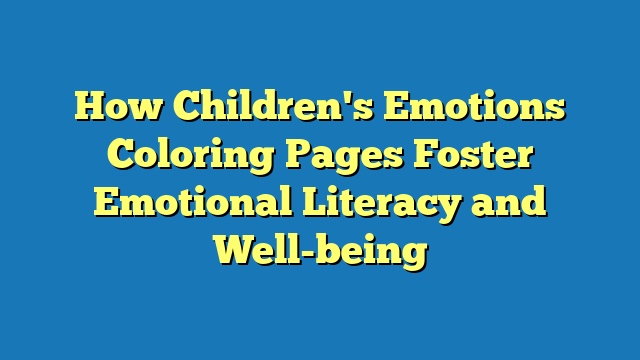Children’s Emotions Coloring Pages: A Tool for Understanding and Expression
Children’s emotions coloring pages are printable worksheets featuring images that depict various emotions, such as happiness, sadness, anger, and fear. These coloring pages provide a tangible way for children to identify, express, and process their emotions.
Children’s emotions coloring pages are beneficial for emotional development, self-awareness, and communication. Historically, these pages have been used as a non-threatening way to explore sensitive topics, such as bullying, grief, and anxiety.
This article will delve into the benefits of children’s emotions coloring pages, providing practical tips for their use in educational and therapeutic settings.
Children’s Emotions Coloring Pages
Key aspects of children’s emotions coloring pages, which provide a safe and engaging way for children to explore and express their emotions, include:
- Emotional identification
- Self-expression
- Emotional regulation
- Communication
- Educational tool
- Therapeutic intervention
- Non-threatening approach
- Age-appropriateness
- Fun and engaging
These aspects are interconnected and contribute to the overall benefits of children’s emotions coloring pages. For example, by identifying and expressing their emotions through coloring, children can develop self-awareness and learn to regulate their emotions more effectively. Coloring pages can also serve as a non-threatening way to initiate conversations about difficult emotions, fostering communication and emotional literacy.
Emotional identification
Emotional identification is a crucial component of children’s emotions coloring pages. It refers to the ability of children to recognize, label, and understand their own emotions, as well as the emotions of others. Children’s emotions coloring pages provide a concrete and engaging way for children to practice emotional identification. By coloring images that depict different emotions, children can begin to associate colors, facial expressions, and body language with specific emotions.
For example, a child may color a picture of a happy face yellow, while coloring a picture of a sad face blue. Over time, the child will begin to associate the color yellow with happiness and the color blue with sadness. This process helps children to develop a vocabulary of emotions and to understand the different ways that emotions can be expressed.
Emotional identification is essential for children’s emotional development. It allows children to understand their own feelings, communicate their needs, and develop empathy for others. Children who are able to identify their emotions are better able to regulate their emotions and cope with stress. They are also more likely to succeed in school and in social situations.
Self-expression
Self-expression is a crucial aspect of children’s emotions coloring pages, as it allows children to communicate their feelings and thoughts in a non-verbal way. Through coloring, children can express themselves freely and creatively, without the constraints of language or social norms.
-
Emotional Release
Coloring pages provide a safe and non-judgmental space for children to express their emotions, both positive and negative. By coloring images that resonate with their inner feelings, children can release pent-up emotions and gain a sense of relief.
-
Self-Discovery
As children explore different colors and images, they begin to discover their own unique preferences and styles. This process of self-discovery can help children to develop a stronger sense of self and to appreciate their own individuality.
-
Communication
Coloring pages can serve as a bridge for communication between children and adults. By sharing their colored pages, children can communicate their thoughts and feelings to others, even if they are not yet able to express themselves verbally.
-
Creativity
Coloring pages encourage children to use their imagination and creativity. By choosing different colors and patterns, children can create their own unique works of art that reflect their own unique perspectives.
The self-expression that children’s emotions coloring pages facilitate is essential for their emotional development. It allows children to explore their emotions in a safe and supportive environment, and it helps them to develop a stronger sense of self and to communicate their thoughts and feelings to others.
Emotional regulation
Emotional regulation is a crucial aspect of children’s emotions coloring pages, as it helps children to manage and control their emotions in a healthy and adaptive way. By engaging with coloring pages, children can practice identifying, understanding, and expressing their emotions, which are all essential skills for emotional regulation.
-
Managing Impulses
Coloring pages can help children to learn how to manage their impulses by providing a structured and focused activity. When children are focused on coloring, they are less likely to act out their emotions in impulsive or destructive ways.
-
Expressing Emotions Appropriately
Coloring pages can provide children with a safe and non-judgmental space to express their emotions in a healthy way. By choosing colors and images that resonate with their inner feelings, children can release pent-up emotions and gain a sense of relief.
-
Understanding Emotional Triggers
As children color and explore different emotions, they begin to develop a better understanding of their own emotional triggers. By identifying the situations and events that trigger specific emotions, children can learn how to avoid or manage these triggers in a healthy way.
-
Developing Coping Mechanisms
Coloring pages can help children to develop healthy coping mechanisms for dealing with difficult emotions. By practicing relaxation techniques, such as deep breathing and mindfulness, while coloring, children can learn how to self-soothe and manage their emotions in a healthy way.
Emotional regulation is a complex skill that takes time and practice to develop. However, children’s emotions coloring pages can provide a valuable tool for helping children to learn how to manage their emotions in a healthy and adaptive way.
Communication
Communication plays a vital role in children’s emotions coloring pages. These coloring pages provide a unique and accessible medium for children to communicate their emotions, thoughts, and experiences.
One of the primary ways that children’s emotions coloring pages facilitate communication is through the sharing of completed pages. When children share their colored pages with others, they are essentially communicating their inner thoughts and feelings. This can be a powerful way for children to connect with others and to build relationships.
In addition, the act of coloring itself can be a form of communication. As children choose colors and make decisions about how to color an image, they are expressing themselves creatively. This can provide insights into a child’s personality, preferences, and emotional state.
Overall, children’s emotions coloring pages are a valuable tool for communication. They provide a safe and non-judgmental space for children to express themselves and to connect with others.
Educational tool
Children’s emotions coloring pages are a valuable educational tool for a number of reasons. First, they can help children to identify and understand their own emotions. By coloring images that depict different emotions, children can begin to associate colors, facial expressions, and body language with specific emotions. This process helps children to develop a vocabulary of emotions and to understand the different ways that emotions can be expressed.
Second, children’s emotions coloring pages can help children to develop self-regulation skills. By practicing identifying and expressing their emotions in a safe and non-judgmental environment, children can learn how to manage their emotions in a healthy way. This can lead to improved behavior, increased academic success, and better relationships with others.
Third, children’s emotions coloring pages can be used to teach children about a variety of topics, including social skills, conflict resolution, and coping mechanisms. By using coloring pages to illustrate different scenarios, children can learn how to handle difficult situations in a positive and productive way.
Overall, children’s emotions coloring pages are a versatile and effective educational tool that can be used to teach children about a variety of important topics. They are a valuable resource for teachers, parents, and other caregivers.
Therapeutic intervention
Children’s emotions coloring pages have gained recognition as a therapeutic intervention for a variety of mental health conditions in children. The therapeutic benefits of coloring pages stem from their ability to provide a safe and non-judgmental space for children to express their emotions, reduce stress, and develop self-regulation skills.
One of the primary ways that children’s emotions coloring pages are used as a therapeutic intervention is through the identification and expression of emotions. By coloring images that depict different emotions, children can begin to associate colors, facial expressions, and body language with specific emotions. This process helps children to develop a vocabulary of emotions and to understand the different ways that emotions can be expressed. Once children are able to identify and express their emotions, they can begin to develop strategies for managing their emotions in a healthy way.
In addition to helping children to identify and express their emotions, children’s emotions coloring pages can also be used to teach children about a variety of therapeutic concepts, such as coping mechanisms, self-soothing techniques, and problem-solving skills. By using coloring pages to illustrate different scenarios, children can learn how to handle difficult situations in a positive and productive way.
Overall, children’s emotions coloring pages are a valuable therapeutic intervention for a variety of mental health conditions in children. They provide a safe and non-judgmental space for children to express their emotions, reduce stress, and develop self-regulation skills.
Non-threatening approach
In the realm of children’s emotions coloring pages, a non-threatening approach is paramount for nurturing emotional development and well-being. It establishes a safe and supportive environment where children feel comfortable expressing their emotions without fear of judgment or reprisal.
-
Age-appropriateness
Coloring pages are designed to be developmentally appropriate, catering to the cognitive and emotional maturity of children at different ages. This ensures that children can engage with the content in a meaningful and relatable way, fostering a sense of comfort and safety.
-
Emphasizing Positive Emotions
While acknowledging the spectrum of human emotions, children’s emotions coloring pages often focus on positive emotions, such as joy, love, and gratitude. This positive framing helps children build a foundation of emotional well-being and resilience.
-
Avoiding Stigmatizing Language
The language used in coloring pages is carefully chosen to avoid stigmatizing or labeling children’s emotions. Instead, it encourages children to view their emotions as natural and acceptable, fostering a sense of self-acceptance and reducing any potential feelings of shame or inadequacy.
-
Encouraging Open Communication
Children’s emotions coloring pages can serve as a catalyst for open and honest conversations about emotions. By providing a non-threatening space for expression, children are more likely to share their feelings and seek support when needed, contributing to their overall emotional health and well-being.
The non-threatening approach embedded in children’s emotions coloring pages is crucial for creating a supportive and nurturing environment where children can explore and understand their emotions in a healthy and positive way. It empowers children to develop emotional literacy, resilience, and a strong sense of self-worth, laying the foundation for their future emotional well-being.
Age-appropriateness
Age-appropriateness plays a pivotal role in children’s emotions coloring pages, ensuring their relevance, engagement, and effectiveness in supporting children’s emotional development.
-
Developmental Stages
Coloring pages are designed to align with the cognitive and emotional developmental stages of children, ensuring that the content and themes resonate with their understanding and experiences.
-
Emotional Complexity
Age-appropriate coloring pages introduce emotions gradually, starting with basic emotions like happiness, sadness, and anger, and gradually incorporating more complex emotions as children mature.
-
Cultural Context
Coloring pages consider cultural norms and values when depicting emotions, ensuring that the expressions and scenarios resonate with children from diverse backgrounds.
-
Skill Level
The complexity of coloring pages, including the number of details and the intricacy of designs, is tailored to the fine motor skills and attention span of children at different ages.
By adhering to age-appropriateness, children’s emotions coloring pages become a valuable tool for fostering emotional literacy, self-expression, and emotional regulation in a manner that is both meaningful and enjoyable for children.
Fun and engaging
Children’s emotions coloring pages are designed to be fun and engaging, captivating children’s attention and making the process of learning about emotions enjoyable. The fun and engaging nature of these coloring pages is a critical component of their effectiveness, as it encourages children to actively participate in the learning process and retain information more effectively.
Real-life examples of fun and engaging children’s emotions coloring pages include those that feature bright colors, whimsical designs, and relatable characters. These elements appeal to children’s natural curiosity and imagination, making the coloring activity more enjoyable and motivating. Additionally, coloring pages that incorporate interactive elements, such as puzzles or games, can further enhance engagement and provide a more dynamic learning experience.
The practical applications of understanding the connection between fun and engaging coloring pages and children’s emotional development are vast. Educators and parents can use these coloring pages as a tool to teach children about emotions, develop their emotional vocabulary, and promote emotional regulation. By making the learning process fun and engaging, children are more likely to develop a positive attitude towards understanding and managing their emotions, which can have a lasting impact on their mental health and well-being.
Frequently Asked Questions on Children’s Emotions Coloring Pages
This section addresses common queries and clarifies essential aspects related to children’s emotions coloring pages.
Question 1: What are children’s emotions coloring pages?
Answer: Children’s emotions coloring pages are printable worksheets featuring images that depict various emotions, such as happiness, sadness, anger, and fear. These coloring pages provide a tangible way for children to identify, express, and process their emotions.
Question 2: What are the benefits of using children’s emotions coloring pages?
Answer: Children’s emotions coloring pages offer numerous benefits, including emotional identification, self-expression, emotional regulation, communication, and therapeutic intervention.
Question 3: Are children’s emotions coloring pages age-appropriate?
Answer: Yes, children’s emotions coloring pages are designed to align with the cognitive and emotional developmental stages of children, ensuring their relevance, engagement, and effectiveness.
Question 4: How can children’s emotions coloring pages be used in educational settings?
Answer: Children’s emotions coloring pages can be incorporated into educational settings as a tool for teaching about emotions, developing emotional vocabulary, and promoting emotional regulation.
Question 5: How can children’s emotions coloring pages be used as a therapeutic intervention?
Answer: Children’s emotions coloring pages can be used as a therapeutic intervention for various mental health conditions, providing a safe and non-judgmental space for children to express their emotions, reduce stress, and develop self-regulation skills.
Question 6: What are some tips for using children’s emotions coloring pages effectively?
Answer: When using children’s emotions coloring pages, it is essential to consider age-appropriateness, encourage open communication, provide a non-threatening environment, and make the activity fun and engaging.
In summary, children’s emotions coloring pages offer valuable support for children’s emotional development and well-being. Their versatility and effectiveness make them a sought-after resource for parents, educators, and therapists alike.
This comprehensive FAQ section provides a strong foundation for the subsequent article sections, which will delve deeper into the applications and benefits of children’s emotions coloring pages.
Tips for Using Children’s Emotions Coloring Pages
This section provides practical tips to maximize the benefits of children’s emotions coloring pages in educational and therapeutic settings.
Tip 1: Encourage Open Communication: Foster a safe and non-judgmental environment where children feel comfortable discussing their emotions while coloring.
Tip 2: Make it Age-Appropriate: Select coloring pages that align with the child’s developmental stage, ensuring relevance and engagement.
Tip 3: Explore Cultural Context: Consider the cultural background of the child and choose coloring pages that resonate with their cultural norms and values.
Tip 4: Integrate Sensory Elements: Enhance the experience by incorporating sensory elements, such as scented markers, glitter, or different textures, to stimulate multiple senses.
Tip 5: Use as a Therapeutic Tool: Utilize coloring pages as a therapeutic intervention to help children express difficult emotions, develop coping mechanisms, and promote self-regulation.
Tip 6: Encourage Creativity and Imagination: Allow children to use their creativity and imagination by providing a variety of coloring materials and encouraging experimentation.
Tip 7: Make it Fun and Engaging: Keep the activity enjoyable by incorporating games, puzzles, or storytelling elements into the coloring process.
Tip 8: Monitor and Provide Support: Observe children’s behavior and provide support as needed, especially when dealing with challenging emotions or sensitive topics.
These tips empower educators, parents, and therapists to effectively harness the potential of children’s emotions coloring pages for emotional development, communication, and well-being.
By embracing these strategies, we can create a supportive environment where children can explore, understand, and express their emotions in a healthy and meaningful way.
The concluding section of this article will explore the broader implications of using children’s emotions coloring pages as a tool for fostering emotional literacy, resilience, and overall well-being.
Conclusion
This comprehensive exploration of children’s emotions coloring pages has highlighted their multifaceted role in promoting emotional literacy, resilience, and overall well-being in children.
Key insights include the effectiveness of coloring pages in fostering emotional identification, self-expression, emotional regulation, and communication. They provide a non-threatening and engaging medium for children to explore and understand their emotions, develop coping mechanisms, and build resilience.
The future outlook for children’s emotions coloring pages is promising, as educators and therapists increasingly recognize their therapeutic and educational value. By embracing these coloring pages as a valuable tool, we can empower children with the emotional skills they need to navigate the complexities of life, foster healthy relationships, and achieve optimal mental health.







